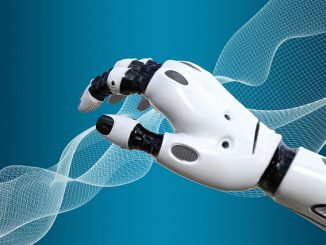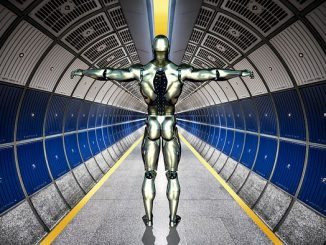Slavery is coming back.
In the future, we’ll all have personal servants. They’ll clean our homes, tend to our gardens, harvest our food, manufacture our goods and fight our battles.
The slaves won’t be human, fortunately, but they will be machines. Every new advance in machine intelligence and electronic sensing, along with other diverse and converging fields of technology, is hastening the adoption of these machine servants.
Robots.
Robots are a big, high-growth field investors need to pay attention to. Bill Gates has predicted that by 2025, robots will be as common as computers are today. If he’s even half right, investors who get in on promising robotics techs today will be fantastically compensated for their vision. Getting in on the next wave of robotics now will be like getting in on Intel, AMD, Apple or Gates’ own Microsoft in the 1980s.
Surgical robots… can make surgery less invasive and more precise, improving recovery times and reducing pain and blood loss. Even your next anesthesiologist could be a robot.
Incidentally, the word “robot” comes from a 1920s Czech science fiction play. The Czech word for servitude, robota, entered the English language as “robot” and has been with us ever since as a description for autonomous or semi-autonomous machines. The name for this field of technology, robotics, also is the product of science fiction — Isaac Asimov first coined the term for a short story in the 1940s.
Although the words date from the 20th century, the idea of self-operating machines is far older. Ancient myths first described artificial and lifelike machines in motion in legendary tales. Later, in the quest to measure time, intricate clockworks — run by weights or springs and self-regulating with mechanisms like pendulums and escapements for accuracy — were developed.
By the early 20th century, electrical controls allowed self-regulating machinery to come into industrial use. After WWII, of course, the invention of modern electronics, based on semiconductors and integrated circuits, meant that industrial automation could become truly “robotic.” Microprocessors and sensors allowed the creation of industrial robots and computer numeric-controlled machinery. By the 1970s, the first microcomputer-controlled robots began to enter factories.
Today, the international automotive industry depends entirely on robots, as do several other manufacturing fields. Chip manufacturing, biotechnology and pharmaceutical companies rely on robotics to perform precise and repetitive functions in environments intolerable to humans.
Industrial robots can be hard to recognize, although the International Organization for Standardization has a working definition: “an automatically controlled, reprogrammable, multipurpose manipulator programmable in three or more axes.” Using these terms, even a modern car might be considered robotic, since some of its internal components meet this definition.
Whatever appearance modern robots take, they form a swiftly growing market. By one estimate by transparency market research, for example, the industrial controls and robotics market was worth $102 billion in 2012, and will grow to $147 billion in 2019. Growth has been strong for years, after a brief pause during the last recession.
Advanced robotics will help solve some of our most vexing problems. In our day and age, the health care industry has proven highly resistant to price declines partly because of labor costs. Improved robotic automation is one way to increase productivity and reduce labor costs. And robots can be used to not only do things cheaper, but better. Surgical robots, for example, can make surgery less invasive and more precise, improving recovery times and reducing pain and blood loss.
Even your next anesthesiologist could be a robot. Johnson & Johnson has developed a “sedation machine” that could replace an anesthesiologist during a colonoscopy. A RAND Corp. study finds that more than $1 billion is spent each year sedating patients during the procedure. Johnson & Johnson believes its automated device can reduce the anesthesiology portion of the bill from over $600 down to $150.
Robot adoption is also being aided by a simple economic fact: While cost of production for goods has generally declined over time because of automation, prices for services generally don’t fall quite as much, because they aren’t as easily automated. Consider that for the performance you receive, your computer costs a fraction of what it did two decades ago, but the technician who repairs it has generally remained quite expensive to hire by comparison.
Automation has solved problems for us in the past. Food prices have fallen steeply in real terms over the last century. This is not only due to better agricultural techniques, but also because of increased automation. From John Deere and Allis-Chalmers, from balers to combines, mechanized agricultural equipment has drastically reduced what we have to pay to for our food. Now we don’t generally worry about going hungry in countries with advanced economies. We worry about consuming too many calories. Automation made this possible.
We may even begin to see fully robotic agricultural operations. A convergence of recent technologies, including GPS, wireless communication and electronic sensors, is heralding a second agricultural revolution. Self-driving tractors, for example, are making their debut, able to automatically follow combines and receive the payload of grains. Another robotic appurtenance, dubbed the Lely Astronaut A4, can milk cows without any need for a human being to be part of the process. The robot even analyzes the milk as it works to monitor for possible bovine health problems.
Within 10 years… personal robots will have the ability to do everything from cleaning toilets… to keeping your schedule and monitoring your vital signs.
Robots also bring new capabilities in other areas. They are already being used for dangerous jobs that humans would rather not do. The U.S. military, for example, is deploying robots in the field and in the air. Some of the earliest recognizable robots were remote-controlled bomb detonation units.
Today, unmanned aerial vehicles can pilot themselves in hazardous situations. Some are sophisticated mobile weapons systems. Many are utility vehicles ranging from self-driving trucks to relatively small “PackBots” that climb stairs, risk tripwires, find land mines and look around corners. Some are armed and can be fired remotely or return fire automatically. Though the public may not think of them as robots, automated missile systems have been around for decades.
One experimental robot, called ATLAS, may be the most advanced humanoid robot ever made. ATLAS’ hydraulically articulated joints enjoy 28 degrees of freedom, and its nimble hands can use human tools. The robot’s sensor suite includes LIDAR, a laser sensor mounted on its head that allows it to measure distances. The military is developing this technology so that in the future, we’ll be better able to deal with disasters like the meltdown at Japan’s Fukushima nuclear plant. Robots can survive in radioactive environments that would quickly kill humans.
Ultimately, the consumer robot market will outgrow military applications as it enters an explosive growth phase. According to ABI Research, this market racked up $1.6 billion in sales in 2012 and will shoot through $6 billion in 2017.
Like industrial robots, consumer ‘bots will become so ubiquitous that they won’t always conform to what we may think of as a robot. As you know, some will look like automobiles. Electric automobile pioneer Tesla Motors expects to be able to build a self-driving car in three years that will be able to perform 90% of the driving. Nissan hopes to field its own autonomous automobiles by 2020. Google is also working hard on this technology.
Robots will enter the home too. iRobot’s Roomba vacuum has been a sales success, but it represents only the beginning. Within 10 years, some roboticists say, personal robots will have the ability to do everything from cleaning toilets and washing dishes to keeping your schedule and monitoring your vital signs.
That may actually be a pessimistic projection. With the leading edge of the boomer generation entering retirement, there will be huge financial incentives for improved service ‘bots. There will be great demand for anyone who can build an affordable robot that can help with housekeeping and basic care. Families that want to keep older members out of assisted care facilities and closer to home will look to robots for help.
In light of this, the famous Japanese enthusiasm for new robot technology is understandable, since more than a fifth of its population is over 65 years old, and the Japanese government is heavily funding robotics projects to provide care and plug holes in the workforce. There are simply not enough young people to take care of an aged Japanese population. The same trend should happen in the U.S. with the baby boomer generation, who are aging in unprecedented numbers.
One thing is certain: the robotic revolution isn’t going anywhere. It’s only getting started.




Leave a Reply